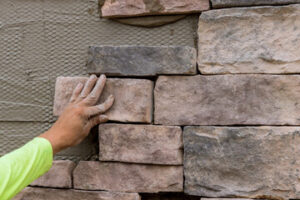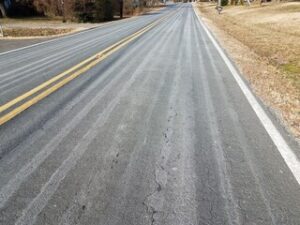Concrete Stone Facing can be made from natural or manufactured materials. Its unique appearance adds value to a home.

Begin by determining how much material you will need. To avoid waste, calculate the number of linear feet you need and subtract the corners. Install a weather-resistant barrier on the wall. Install galvanized metal lath or 1″ woven wire stucco netting overlapping and wrapping the edges by at least 16 inches.
Real quarried stone is an impactful addition to any home. It can be incorporated into rustic, farmhouse and even minimalist aesthetics to create an authentic look. But if you’re looking for the look of stone without the cost, weight and hassle of real stones, mortarless easy-to-install stone veneer is an excellent choice.
Rather than being made of porous cement like real stone, mortarless easy-to-install stone is a manufactured product that is precast into dimensional slabs and then left to cure until it reaches the proper psi strength. The result is a durable, lightweight product that can be installed over a variety of substrates such as wood sheathing, concrete block, metal siding or concrete walls.
This type of stone veneer is offered in panelized systems as well as individualized stone sizes to suit any space and design requirement. To install the product, you will need to ensure that your wall is plumb and provide a backing for the veneer. This can be done by installing a 3mm to 6mm polyethylene foam pad, a closed-cell foam, or compressible foam bond breakers that allow for free movement of the stone and prevent it from adhering to the wall.
Then install the galvanized metal lath over the moisture barrier, making sure to overlap the corners a minimum of 4”. Galvanized nails or screws should be used and placed every 8” on center vertically and 16” on center horizontally penetrating the studs a minimum of 1”.
Next, wash all the stone veneer pieces with water to remove any dirt, sand or loose particles that may interfere with the adhesive. This also helps to remove any blemishes or scratches that could show through the grout after installation. It’s also a good idea to lay out your stone on the ground and determine a layout before starting the project as this can save you from excessive trimming later.
Once the metal lath has been installed, you can begin to apply a scratch coat using your trowel. This will help the mortar adhere to the metal lath and provide a smooth surface. After applying a thin coat of scratch, you can begin to install the stone. Always back butter each stone before pressing it into the wall to build up a bond coat. This step is vital to the longevity of your project.
Versatile
Concrete stone veneer is a versatile cladding material used on residential and commercial projects to add a rich, upscale look. It can be installed over a concrete or masonry substrate and, when properly installed and maintained, will provide years of beauty and durability.
Manufactured stone veneer is a type of concrete product that is molded and colored to resemble natural stone. It is a popular choice for people who want the appearance of real stone but cannot afford the cost of genuine stones. It can be installed over concrete, masonry, or wood, and can be grouted just like natural stone.
When used for exterior cladding, stone facing is available in a wide range of colors, styles, and sizes to suit any architectural style. It can be used to craft an accent wall, a chimney, or to completely clad an entire building façade. It can also be used to create decorative elements like columns, arches, or window surrounds.
In addition to its versatility, stone veneer is also an excellent option for garden walls, walkways, driveways, and other landscape features. It is available in a variety of colors, textures, and shapes to complement any design style, and can be installed in a variety of patterns, including running bond, herringbone, or stacked bond.
Natural stone is a beautiful and elegant material that can add a touch of class to any project. However, it can be difficult to install on a budget, and it can be susceptible to stains and damage. Concrete stone veneer is a cost-effective alternative that offers the same aesthetic and durability as real stone.
The advantage of concrete stone veneer is that it can be installed without the need for a footing or other foundational components, and can be applied to existing masonry or concrete surfaces. It is also easy to maintain, as it requires less upkeep than traditional masonry materials.
Unlike concrete block, stone veneer is not porous and is therefore less prone to color variation. To ensure consistent results, it is important to mix the concrete well. The TEK recommends mixing a ratio of 1 part type S masonry cement to 2.5 parts sand to achieve a smooth consistency. It is also recommended to use a concrete colorant that will blend in seamlessly with the surrounding stones, such as masonry grey or white.
Durable
The concrete used to cast stone facing is incredibly durable and resistant to wear and tear. It is also weatherproof, making it a great option for exterior walls in climates with changing temperatures. It can easily withstand heavy rains, snow and hail, as well as strong winds. The material is easy to maintain, requiring only occasional rinsing with the garden hose to remove dirt and moss. In addition, stone veneers can add value to a home by providing a more sophisticated look than simply leaving the wall bare or painting it.
Manufactured stone veneer is made of an aggregate, Portland cement and iron oxide pigments, which create a lightweight stone replica with a wide range of styles. It can be applied to concrete or concrete masonry surfaces, wood sheathing or metal lath. In these applications, a scratch coat is usually required to ensure a strong mortar bond. It is not recommended that manufactured stone veneer be attached to clay masonry surfaces or over wet locations like walls near swimming pools and hot tubs. If placed in these areas, it may be necessary to treat the veneer with a silane-based, non-film-forming, breather-type masonry sealer to protect against moisture and staining.
In contrast, natural stone is one of the heaviest building materials and requires a highly skilled mason to install it correctly. Whether it’s granite, limestone or slate, each piece of real stone has its own unique appearance that cannot be replicated by artificial products. This natural look can increase a property’s value and help it stand out from other homes in the neighborhood.
A masonry professional can help you decide which type of stone to use in your project, including weighing the pros and cons of each. If you opt for natural stone, it is important to choose a trusted contractor who can install the material properly and ensure that it’s protected from moisture. It’s also a good idea to have a plan for the layout of the stones so you can visualize how they will look once they are in place. This will help you determine the sizing and color of each individual piece, how they should be laid out on the wall and if any trimming is needed.
Affordable
Stone adds a classic look to homes, both interior and exterior. However, natural stone is typically more expensive than other materials for home construction, especially when the extra considerations of increased structural support and construction costs are incurred. The good news is that a stone veneer facing solution is an affordable alternative to traditional stone cladding.
The cost of a stone veneer depends on the material, the installation method and how much space you are covering. When installing a stone veneer, contractors may charge a labor fee to complete tasks like measuring, adding mortar and area preparation. The type of stone and color chosen will also play a factor in the overall cost.
While cheaper cultured stone walls are available, they are often painted and have limited color choices compared to the full spectrum of real stone. Unlike cheap concrete wall products, natural stone is the original green building product and does not require dyes, cement or chemicals.
Natural stone is the perfect material for retaining walls because of its durability and long lifespan. In a typical residential application, a retaining wall is built to stabilize an existing slope of soil and can be used for landscape features such as stairs or walls to create a unique outdoor living space. In addition, the natural mass of a retaining wall provides a great deal of insulation for buildings and reduces energy costs.
Retaining wall manufacturers offer a variety of stone styles, such as rustic Fieldstone and timeless Limestone. These stone products are available in a range of shapes and sizes to suit a wide variety of aesthetics, both modern and contemporary. In addition to the aesthetics, a retaining wall provides a sturdy foundation for landscaping and gardening.
Manufactured stone is a concrete product molded and colored with durable iron oxide pigments to mimic various types of natural stone. This is a great option for cladding because it looks just like real stone, but it is less expensive and lighter in weight. This is important because it can save on the cost of building materials and labour for installing the cladding.

